The teeth of the Megalodon, which means “big tooth,” are among the most sought-after fossils by collectors and enthusiasts. Not only are these teeth enormous—many of them measure over six inches in length—but they also bear witness to the Megalodon’s incredible size and power.
Maryland’s waters and coastal regions were once home to these giant predators, making them a prime spot for finding these remarkable fossils today.
Our article is meant to help fossil hunters of all levels, especially first-timers, find Megalodon teeth in Maryland. It gives helpful information on the best places to look for fossils, the tools you need, and the best times to search.
It also gives readers a full picture of what to look for and how to identify them. With our guide, you will be ready to go on an exciting adventure to find Megalodon teeth!
What Megalodon Tooth Is
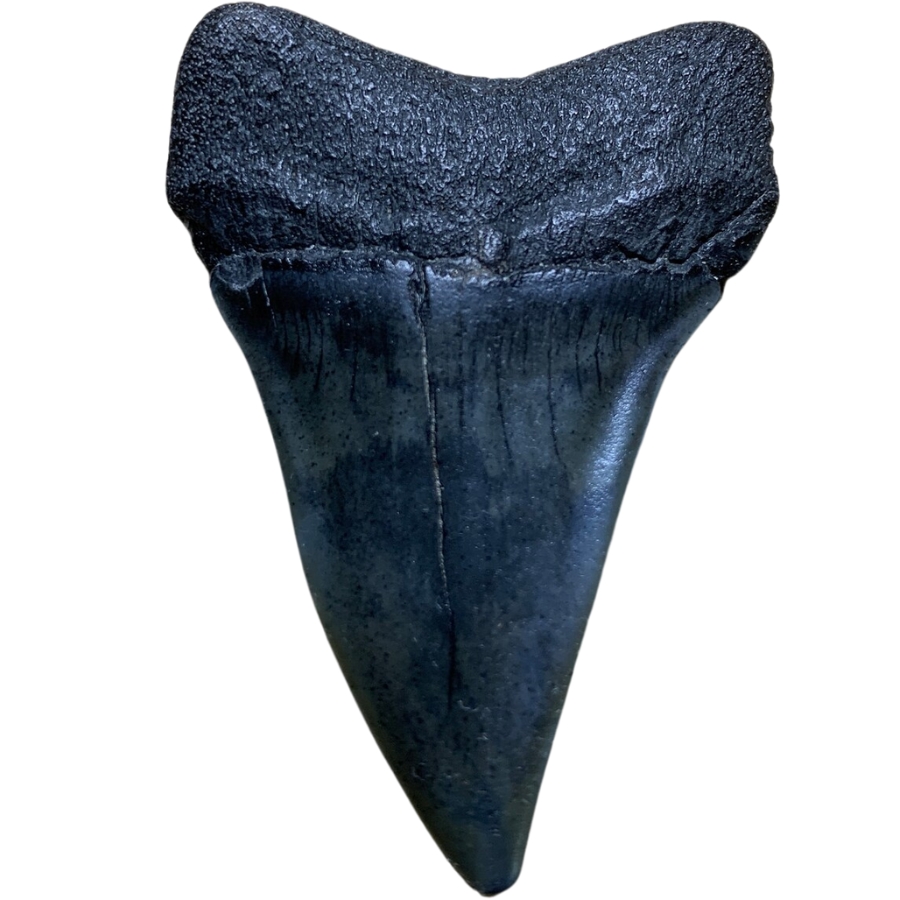
The Megalodon shark was a huge prehistoric shark that lived millions of years ago. Its teeth are fossilized remains of teeth that it had.
These teeth are very big, often bigger than a human hand, and have a triangular shape with serrated edges, perfect for eating large sea creatures. The teeth are rich, fossilized black or brown, and very hard and heavy.
Megalodon teeth are much bigger than the teeth of any living shark, even the Grea. The size and condition of the teeth can vary greatly depending on these factors.
Megalodon teeth are found worldwide, but are most frequently found in regions that were once underwater and are rich in marine fossils. They are frequently found in riverbeds, ocean floors, and coastal sediment layers.
In addition, archaeologists may find megalodon teeth in phosphate mines and gravel pits, which are disturbed earth formations that bring these ancient treasures closer to the surface.
- The deep experience and understanding of our team about the area
- Recommendations from local groups and clubs
- How easy it is to get the a particular location
- Safety and potential hazards when collecting
- Weighing private and public locations
- The ability for both experienced and novice enthusiasts to find great samples
With these factors in mind we’ve been able to put together a fantastic list that just about anyone can use!
It’s really easy to pass up on great finds without a little guidance. A lot of you are making some mistakes with what you’re throwing away.
DON'T MISS OUT ON ANY GREAT FINDS!
While you're out searching for Megalodon Teeth you're going to find A LOT of other interesting rocks and minerals along the way. The last thing you want to do is toss out something really interesting or valuable. It can be easy to misidentify things without a little guidance.
You absolutely need a good reference guide in order to understand what you're looking at!
We've put together a fantastic field guide that makes identifying 140 of the most interesting and valuable rocks and minerals you will find REALLY EASY. It's simple to use, really durable, and will allow you to identify just about any rock and mineral you come across. Make sure you bring it along on your hunt!
Now, back to the identification specifics:
The Best Places To Find Megalodon Tooth In Maryland
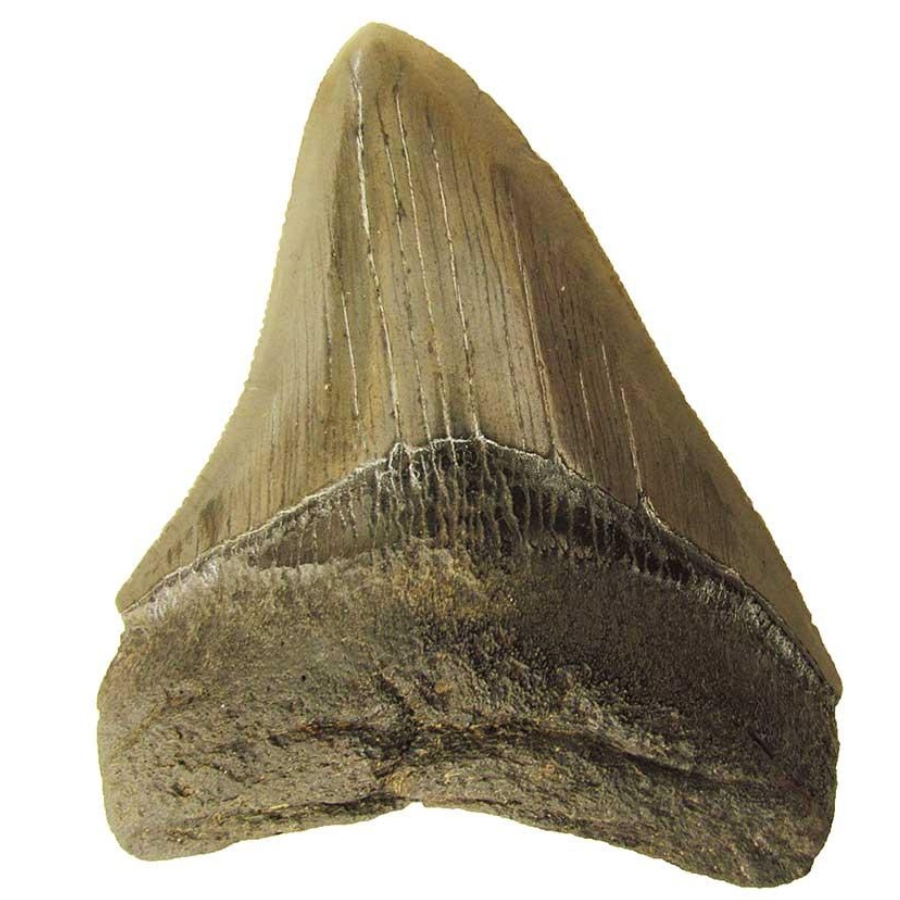
Let us discuss about the greatest sites in the state to discover megalodon tooth. There are a lot of locations to find gems in Maryland, but only a handful are suitable for megalodon tooth specimens. These are beautiful locations that not many people know about!
Always Confirm Access and Collection Rules!
Before heading out to any of the locations on our list you need to confirm access requirements and collection rules for both public and private locations directly with the location. We haven’t personally verified every location and the access requirements and collection rules often change without notice.
Many of the locations we mention will not allow collecting but are still great places for those who love to find beautiful rocks and minerals in the wild without keeping them. We also can’t guarantee you will find anything in these locations since they are constantly changing.
Always get updated information directly from the source ahead of time to ensure responsible rockhounding. If you want even more current options it’s always a good idea to contact local rock and mineral clubs and groups
Breezy Point
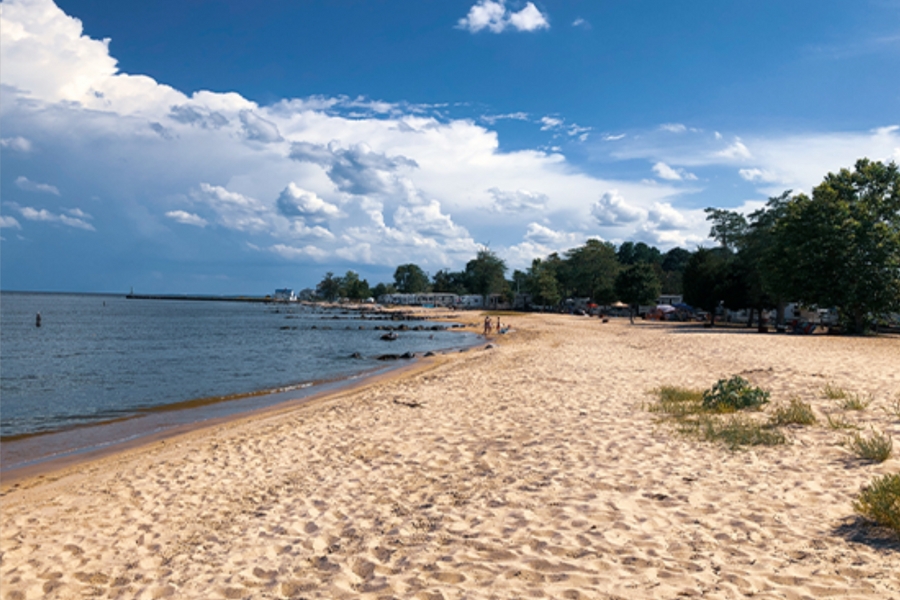
Breezy Point and its surroundings are full of fossilized remains, including the highly sought-after Megalodon teeth, which are not only enormous—often larger than a human hand—but also tell a story about the life and environment of these enormous prehistoric sharks.
It’s a remarkable place for those interested in discovering the past, particularly finding Megalodon teeth. This area, rich in geological history, was once part of an ancient ocean that housed the Megalodon, a gigantic prehistoric shark.
For novice and expert fossil hunters, Breezy Point’s natural setting makes it an exciting and accessible location.
Where we found megalodon tooth at Breezy Point
These historic gems may be visible amid the pebbles and sand when you stroll along the beaches or the water’s edge, particularly during storms or high tides.
DON'T MISS OUT ON ANY GREAT FINDS!
While you're out searching for Geodes you're going to find a lot of other interesting rocks and minerals along the way. The last thing you want to do is toss out something really interesting or valuable. It can be easy to misidentify things without a little guidance.
We've put together a fantastic field guide that makes identifying 140 of the most interesting and valuable rocks and minerals you will find REALLY EASY. It's simple to use, really durable, and will allow you to identify just about any rock and mineral you come across. Make sure you bring it along on your hunt!
Calvert Cliffs
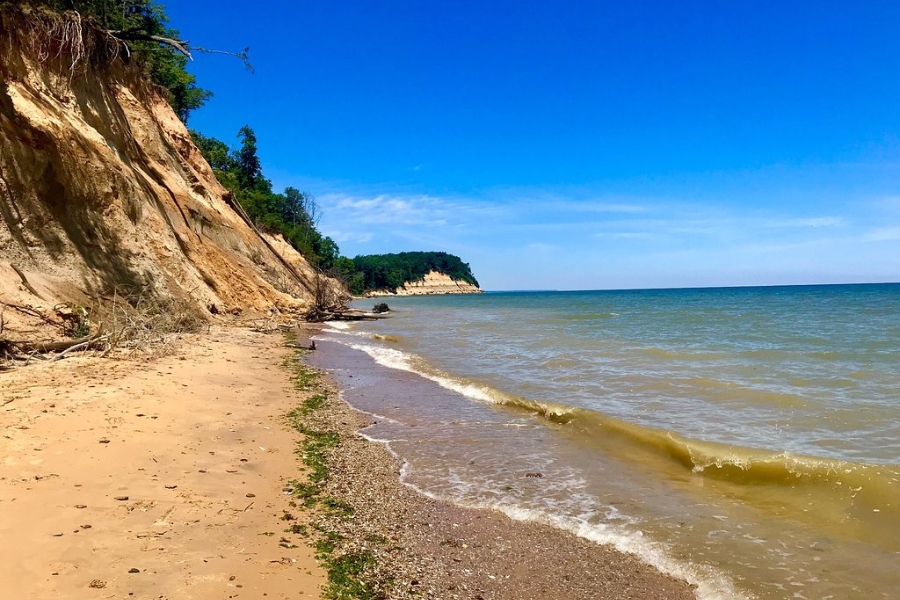
The Megalodon, a massive prehistoric shark that once swam in these waters, and its teeth are among the most prized finds at Calvert Cliffs.
Stretching along the Chesapeake Bay, these cliffs are part of a geological formation that dates back millions of years to the Miocene epoch.
Over time, the cliffs have eroded, revealing a treasure trove of fossils, including shark teeth, whale bones, and other ancient marine life remains.
The Megalodon teeth found here are known for having sharp, triangular tips and can be quite big—some are even the size of a person’s hand.
Where we found megalodon tooth at Calvert Cliffs
Megalodon teeth are best found on the beaches at the base of Calvert rocks. Fossils often wash up on the shore, especially after storms or high tides that wear away at the rocks and reveal hidden treasures.
Chesapeake Bay
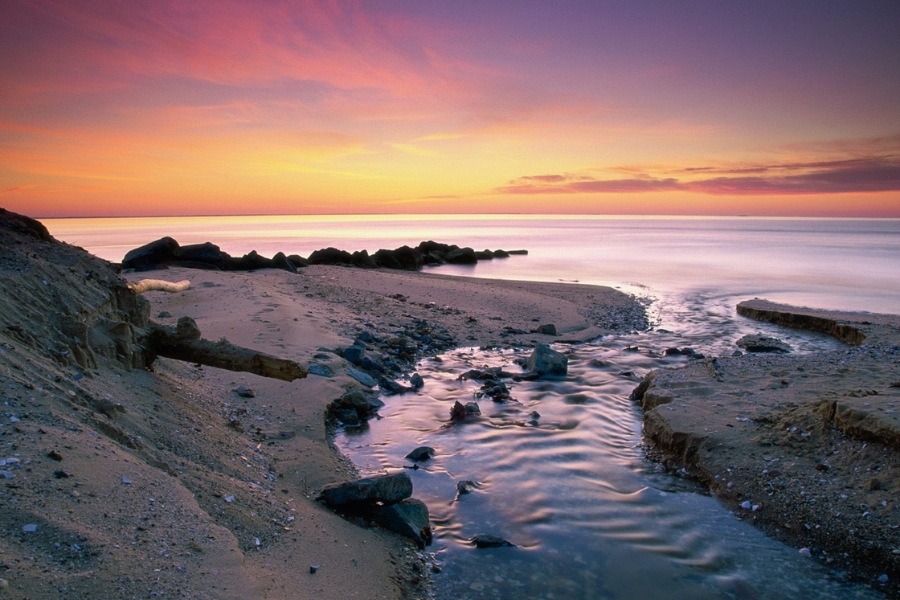
Chesapeake Bay is a great place to learn about prehistoric marine life, especially Megalodon teeth. This bay, which is the largest estuary in the country, has a history that goes back millions of years.
It was home to the Megalodon, a huge prehistoric shark, and today, fossil hunters love the bay’s waters and the land around it. The Megalodon teeth found here are impressive—often bigger than a human hand.
The bay’s varied environment and waterways make it easy for both new and experienced fossil hunters to find interesting things.
Where we found megalodon tooth at Chesapeake Bay
You can start by looking at the beaches along the bay and the sides of rivers that flow into the Chesapeake Bay. These places are often where fossils, like Megalodon teeth, are found because of erosion.
Matoaka Beach
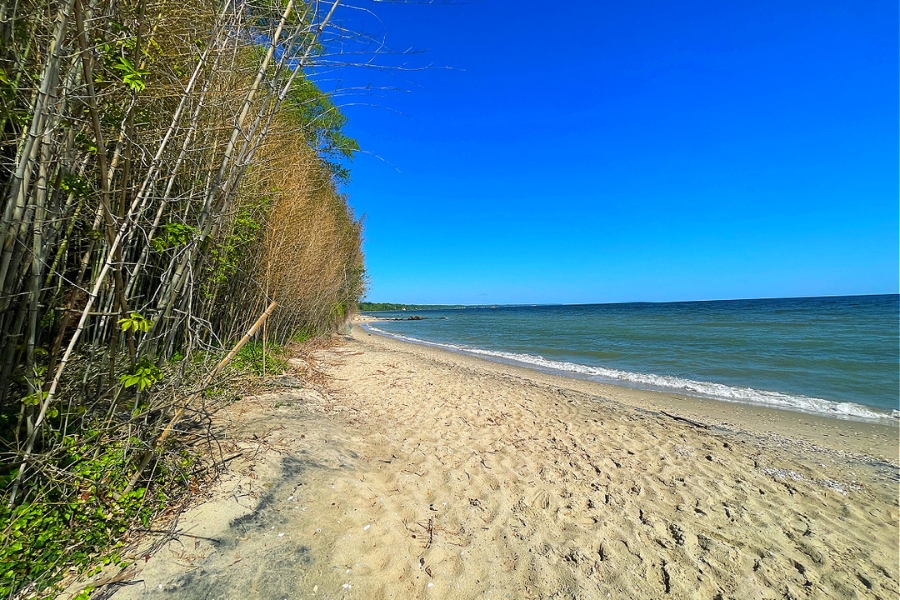
Many people like to visit Matoaka Beach to learn about the past, especially to look for Megalodon teeth. This beach is on the Western Shore of the Chesapeake Bay, which is full of fossils from millions of years ago.
The geological history of this area makes it a great place to find Megalodon teeth because it was once part of an ocean where the Megalodon, a huge prehistoric shark, lived.
There are exposed cliffs at Matoaka Beach that date back to the Miocene era. Over time, water and wind have worn away sediment layers full of fossils.
Finding Megalodon teeth after storms or at low tide is easier when new fossils are washed onto the beach. These teeth are rare and often more significant than a person’s hand. They have a sharp, serrated edge and a triangular shape.
Where we found megalodon tooth at Matoaka Beach
The best place to start is along the beach’s shoreline. As the water and waves erode the cliffs, they can reveal fossils and wash them up onto the beach.
Potomac River
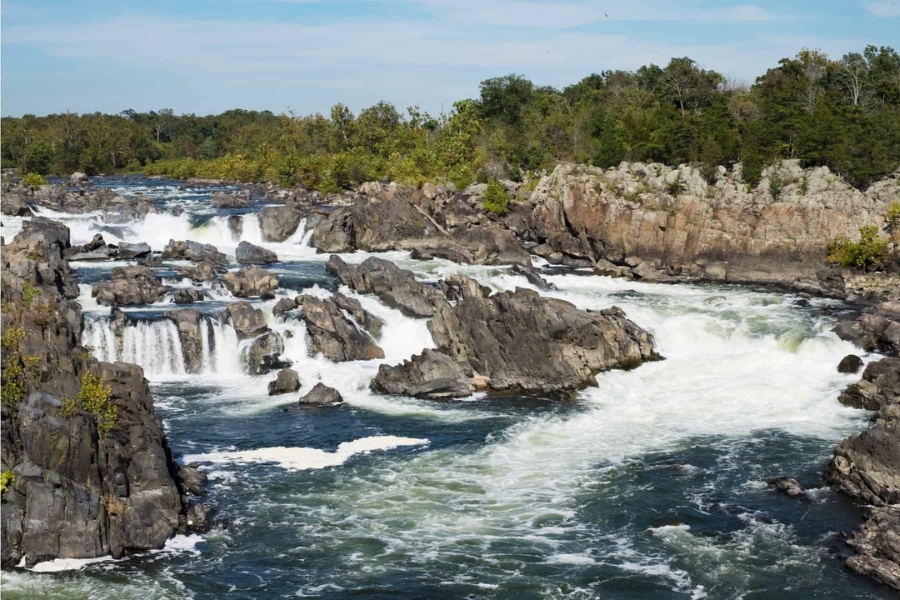
For people interested in the past, the Potomac River is a great place to find Megalodon teeth. This historic river flows through areas once part of a huge ocean, so it’s home to many fossilized remains, including those of the vast Megalodon shark.
When these teeth are found, they are a thrilling discovery because they are often bigger than a human hand and have triangular shapes with serrated edges that show how big the shark was.
The Potomac River is a great place to find fossils because it has a lot of sediments. These sediments have preserved the remains of marine life that used to live here for millions of years.
The water and weather always wear away at the river’s banks and nearby cliffs, revealing layers of earth where fossils can be found.
Where we found megalodon tooth at Potomac River
You can start your search along the Potomac River and nearby beaches. Look in places where the water has worn away at the banks, as this can reveal fossil layers.
Other Great Places To Find Megalodon Tooth
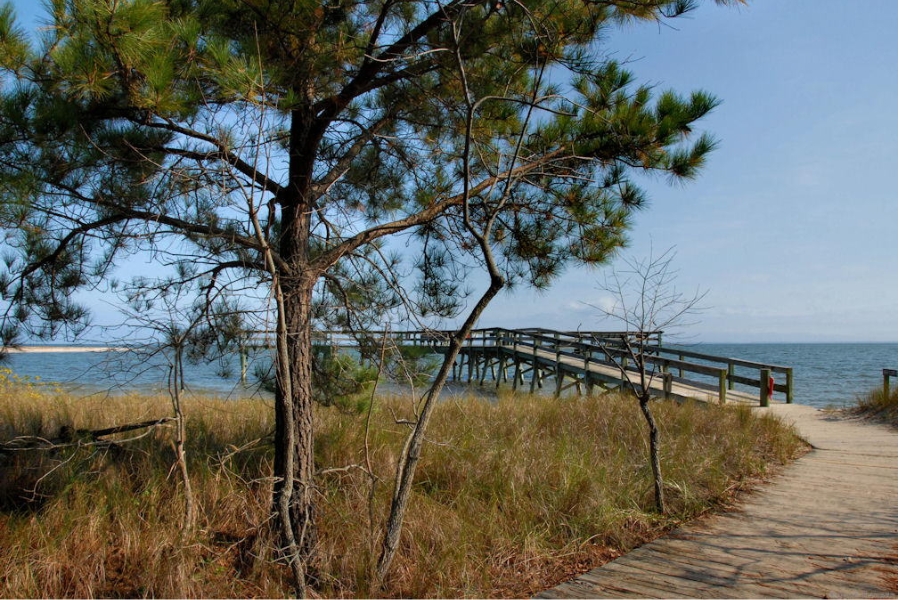
As you explore and walk along beaches and riverbanks, always keep an eye out for megalodon tooth. Here are some more places, listed by county, where your search might also pay off.
Our recommendations by county
| County | Location |
| Calvert | Flag Ponds Nature Park |
| Charles | Purse State Park |
Common Megalodon Tooth Questions

When people want to know where to find megalodon teeth in Maryland, they often ask these questions.
Is it illegal to collect megalodon tooth in Maryland?
While it is generally legal to collect Megalodon teeth in Maryland, there are some important rules and regulations that fossil hunters should be aware of.
It depends on a number of factors, such as where the location is made and who owns the land, whether or not it is legal to collect Megalodon teeth or any other fossils.
The Best Places To Buy Megalodon Fossils in Maryland

If you do not want to get dirty and work hard to find megalodon tooth, this list is for you. These are some of the best places in the state to find and buy megalodon tooth:
- Caldron Crafts – 6611 Baltimore National Pike, Catonsville, MD 21228, United States
- Earthly Rocks – 33 N Market St, Frederick, MD 21701, United States
- GTC Rock Shop – 5500 Buckeystown Pike, Frederick, MD 21703, United States
- Knowles Rock Shop – 10400 Connecticut Ave #100A, Kensington, MD 20895, United States
- Mahalo Minerals – 8300 Eastridge Ave, Takoma Park, MD 20912, United States

